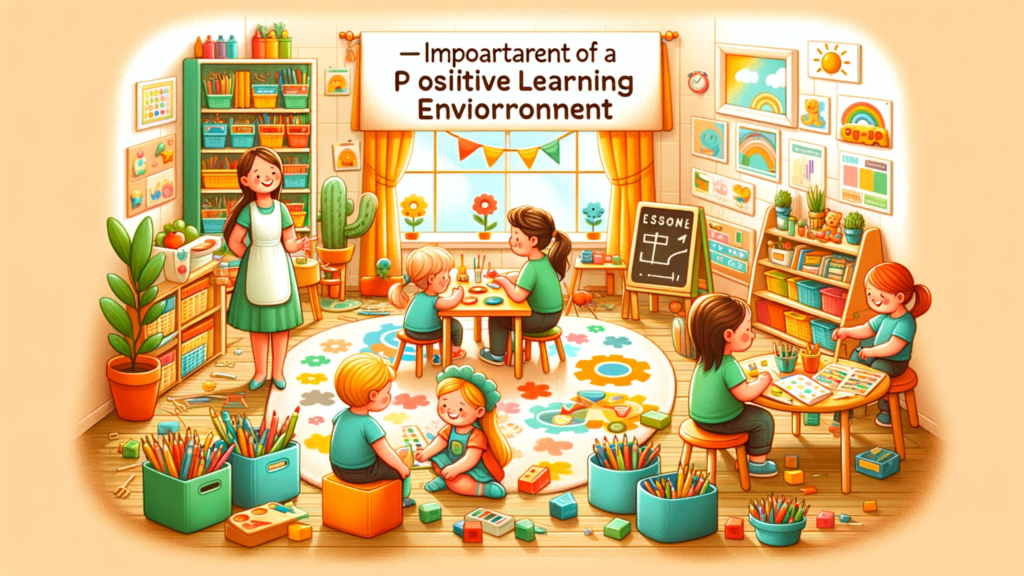In the early years of a child’s life, the home serves as their first and most influential learning environment. Creating a positive learning environment at home for preschoolers is essential to foster their development and set the stage for a lifetime of curiosity and love for learning. In this article, we will explore various strategies and tips to help parents and caregivers transform their homes into nurturing and enriching spaces where preschoolers can thrive academically, emotionally, and socially.
Importance of a Positive Learning Environment
A positive learning environment plays a crucial role in a preschooler’s cognitive and emotional development. It sets the tone for their attitude towards learning, shapes their self-esteem, and influences their overall well-being.

Here’s why creating such an environment at home is so important:
- Encourages Curiosity: A positive learning environment sparks a child’s curiosity and eagerness to explore. When a child feels safe and supported at home, they are more likely to ask questions, experiment, and seek knowledge.
- Builds Confidence: Preschoolers who grow up in a nurturing environment tend to develop higher levels of self-confidence and self-esteem. They feel more capable of tackling challenges and trying new things.
- Supports Social Skills: Interactions with family members in a positive learning environment help preschoolers develop essential social skills like communication, empathy, and cooperation.
- Boosts Academic Achievement: A well-structured learning environment at home can enhance a child’s readiness for school and contribute to better academic performance in later years.
Steps to Create a Positive Learning Environment at Home for Preschoolers
Now that we understand why it’s crucial let’s explore how to create a positive learning environment at home for preschoolers.
Establish a Routine
Preschoolers thrive on routine and predictability. Establishing a daily schedule can help create a sense of stability and security. Plan specific times for learning activities, meals, play, and rest. Consistency helps children understand expectations and feel more in control of their day.
Create a Dedicated Learning Space
Designating a specific area in your home for learning activities can work wonders. Whether it’s a corner in the living room or a separate room, make sure this space is well-organized and free from distractions. Stock it with age-appropriate books, educational toys, art supplies, and other learning materials.
Use Positive Reinforcement

Praise and positive reinforcement are powerful tools for creating a positive learning environment. When your preschooler accomplishes a task or shows enthusiasm for learning, offer words of encouragement and appreciation. This positive feedback helps build their self-esteem and motivation.
Foster Independence
Encourage your child to take the lead in their learning. Provide opportunities for them to make choices, set goals, and solve problems. As they gain independence, they become more engaged and motivated to learn.
Make Learning Fun
Preschoolers learn best when they’re having fun. Incorporate play-based learning into your daily routine. Use games, puzzles, and interactive activities to teach concepts such as counting, colors, and shapes. Learning should be an enjoyable adventure rather than a chore.
Be a Role Model
Children often learn by imitating adults. Be a positive role model for your preschooler by demonstrating a love for learning, curiosity, and a growth mindset. Show them that learning is a lifelong journey, and mistakes are valuable opportunities to grow.
Encourage Exploration
Provide opportunities for hands-on exploration. Take nature walks, visit museums, and engage in activities that allow your child to discover the world around them. Encourage questions and discussions to nurture their natural curiosity.
Read Together
Reading is one of the most effective ways to create a positive learning environment. Set aside time each day to read together. Choose age-appropriate books that capture your child’s interests and imagination. Reading not only enhances language skills but also fosters a love for storytelling and learning.
Limit Screen Time
While technology can be a valuable learning tool, it’s essential to set limits on screen time for preschoolers. Excessive screen time can hinder social interaction and active play. Focus on interactive, educational apps and programs when allowing screen time.
Involve the Family

Creating a positive learning environment is a collective effort. Involve other family members in your child’s learning journey. Encourage grandparents, siblings, and extended family to participate in activities and discussions. This strengthens family bonds and provides diverse learning experiences.
Adapt to Individual Needs
Every child is unique, and their learning needs may vary. Pay attention to your child’s interests, strengths, and challenges. Adapt your approach to meet their individual needs, and be flexible in your teaching methods.
Encourage Questions
Preschoolers are naturally curious and full of questions. Encourage them to ask why, how, and what if. Answer their questions patiently and explore together to find answers when you don’t know. This fosters a sense of inquiry and critical thinking.
Celebrate Achievements
Celebrate your child’s milestones and achievements, no matter how small they may seem. Create a sense of accomplishment by acknowledging their efforts and progress. This positive reinforcement motivates them to continue learning.
Conclusion
Creating a positive learning environment at home for preschoolers is a rewarding and essential journey for parents and caregivers. By following the strategies outlined in this article, you can help your child develop a love for learning, build self-confidence, and prepare them for a successful academic journey ahead. Remember that a positive learning environment is not just about academics; it’s about nurturing their overall growth and well-being. With your guidance and support, your preschooler can thrive in the comfort and love of their home, laying a strong foundation for a bright future.
Start A New Chapter In Your Child’s Education
At Kids Learning Academy, we’re dedicated to fostering the holistic development of your child. Our carefully designed programs are crafted to ignite their curiosity, enhance their cognitive skills, and nurture their creativity. We believe in providing a safe and stimulating environment where children can thrive. Join us in this exciting journey of growth and learning. Enroll your child today to give them the best start in life!